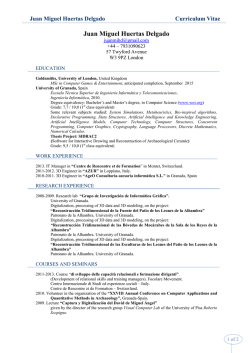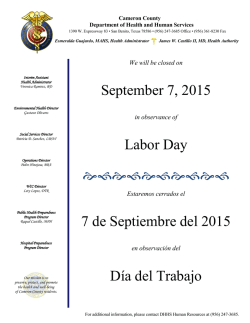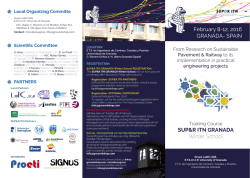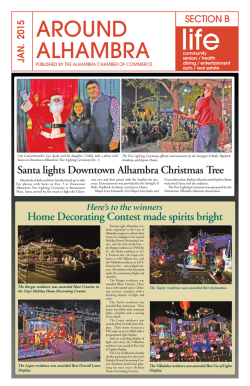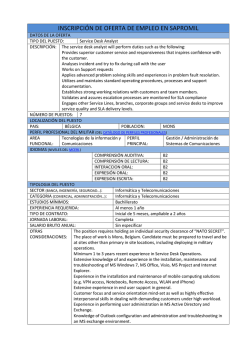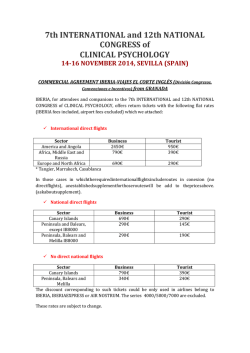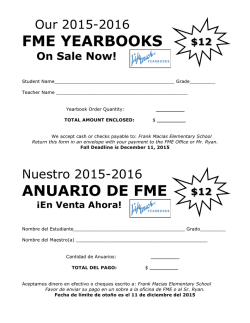
NEH Institute Syllabus.16 - Laboratorio de Arqueología y
NEH Summer Institute for College and University Teachers (2015) The Alhambra and Spain’s Islamic Past Hosted in Granada by the Laboratorio de la Arqueología y Arquitectura de la Ciudad (LAAC), Escuela de Estudios Árabes (EEA), Consejo Superior de Investigaciones Científicas (CSIC) Co-Directors: D. Fairchild Ruggles and Oscar E. Vázquez SYLLABUS Per NEH policy, the Institute meetings are open only to Scholars in the Summer Institute. The exception is events marked with an asterisk ( ). Week 1 (June 15-19) - The Alhambra as an Islamic palace complex, 13th-15th centuries Monday, June 15 9:00am-10:00am (Carmen de la Victoria terrace) – Introductions. Whether you are living at the Carmen or off site, please arrive no later than 9:00 and gather on the upper terrace. 10:30-12:30 (LAAC seminar room) – Dr. Antonio Orihuela, Director: Welcome. Explanation of Institute customs and requirements; followed by introductory lecture on Islamic Spain and Granada. 6:00pm (Meet on the terrace of the Carmen de la Victoria) – Walk through the Albaicín to see the new mosque at the Plaza de San Nicolas, the Puerta de Pesos, various cisterns, and the minarets/towers of San José and San Juan de los Reyes. Readings for June 15 & 16: N.B. Because the Institute is held in English, we have selected readings in English. However, for those participants wishing to explore in greater depth, there is a much larger bibliography in Spanish. We can direct Summer Scholars to these resources. • • • • • D. Cabannelas Rodríguez, “The Alhambra: An Introduction,” Al-Andalus: the Art of Islamic Spain (Metropolitan Museum of Art, 1992), pp. 127-33. J. Dickie, “The Palaces of the Alhambra,” in Al-Andalus: The Art of Islamic Spain, ed. Jerrilynn Dodds (Metropolitan Museum, 1992), pp. 135-51. D. F. Ruggles, Gardens, Landscape and Vision in the Palaces of Islamic Spain (2000), pp. 163-208. O. Bush, “The Writing on the Wall: Reading the Decoration of the Alhambra,” Muqarnas (2009): 119-147. J. M. Puertas Vílchez, Reading the Alhambra (2011), pp. 13-23 and 206-219. NEH Institute Syllabus (16) – 12 June 2015 2 Tuesday, June 16 – First ALHAMBRA Visit 8:00am – (Meet at the main gate of the Carmen to walk together to the Alhambra bus on the Plaza Isabel la Católica. Off-site dwellers will meet at the Plaza Isabel la Católica at 8:30). Visit to the Alhambra and Generalife. In this visit we focus on the palace complex as a Nasrid monument. 9:00-10:30 Groups 1 and 2 enter Alhambra with Dede. Groups 3 and 4 visit Generalife with Oscar. 11:00-12:30 Groups 3 and 4 enter Alhambra with Dede. Groups 1 and 2 visit Generalife with Oscar. 1:00-1:45pm Groups 1-4 reunite for special visit to the Torre de las Infantas and Torre de la Cautiva. Wednesday, June 17 9:00-10:00am (LAAC) – Meeting in groups to discuss projects on selected historical travelers and visitors to the Alhambra (Washington Irving, Theophile Gautier, Henry Swinburne, Richard Ford, John Frederick Lewis, etc.). Some texts are available in the library of sources provided to you, but you will need to seek other sources. These are group projects to be presented in Week 2. 10:30am-12:30pm (LAAC) – Guest speaker Jerrilynn Dodds: “‘Convivencia’ and the Medieval Iberian Peninsula: the values and perils of a historical concept.” Reading for this meeting: • H. K. Bhabha, “Cultural Diversity and Cultural Difference,” in The Post-Colonial Studies Reader, ed. Askcroft, Griffiths and Tiffen (1995), pp. 206-13. • J. D. Dodds, M. Menocal, and A. Balbale, “Brothers” and “Intimacy Betrayed,” in The Arts of Intimacy (2008), pp. 241-69. Also recommended: • A. Balbale, “Cacophony,” Journal of Medieval Iberian Studies, 5 (2013): 123-8. • J. D. Dodds, “Hunting in the Borderlands,” Medieval Encounters 14 (2008): 267-302. 1:00 -2:00pm – Site visit to the Fundación del Agua de Granada in the Carmen del Rey 6:30-8:30pm (LAAC) – Presentations: • • “Archaeological projects of LAAC: El Agdal (Marrakech), Onda, Murcia and Siyâsa” by Julio Navarro, Pedro Jiménez and Fidel Garrido (Escuela de Estudios Árabes, CSIC). “The andalusí architectural heritage of the Albaicín (Granada)” El patrimonio arquitectónico andalusí del Albaicín de Granada” by Antonio Orihuela and Luis García (Escuela de Estudios Árabes, CSIC). 3 Thursday, June 18 9:00am-1:00 (meet at Carmen terrace) – Walk to the 16th-century Casa del Chápiz, 14thcentury Cuarto Real de Santo Domingo, and 14th-century Alcázar Genil for discussion/tour with guest speaker Antonio Almagro (Escuela de Estudios Árabes, CSIC). 6:00-7:20pm (Carmen, Sala de Actos) – Jerrilynn Dodds, “Mudejar: Beyond Religion and Identity.” Reading: • J. D. Dodds, M. Menocal, and A. Balbale, “Union,” in The Arts of Intimacy (2008), pp. 113-143. • D. F. Ruggles, “Mudejar Teruel and Spanish Identity,” in The Literature of Al-Andalus ed. M. Menocal et al (2000), pp. 413-14 N.B. LAAC-sponsored lecture at 7:30pm at the Escuela de Estudios Árabes (Cuesta del Chapiz, 22): Miguel Ángel Tabales Rodríguez, “La construcción del primitivo alcázar de Sevilla: nuevos datos sobre el proceso de obra, materiales y técnicas.” Friday, June 19 Morning open to allow consultation of the EEA library (open until 3:00pm) and Alhambra library & archives (M-F 8:30-1:30). Oscar, Dede and Jerri Dodds available for consultation. 5:15-6:15 (Carmen terrace)—group discussion and summary of Week 1. 6:30-8:00pm (Carmen, Sala de Actos) – D. F. Ruggles, “Materiality and Originality: The Alhambra as Historic Trace.” Week 2 (June 22-26) – The Alhambra in literature and the historical imagination Monday, June 22 9:00-10:30am (LAAC) – Discussion of the Alhambra as heritage. Reading: • B. Anderson, Imagined Communities (1991), pp. 1-48. • D. Lowenthal, The Past Is a Foreign Country (1985), pp. 3-34, 263-362. • P. Nora, “General Introduction: Between Memory and History,” in Nora, Realms of Memory (1995), pp. 1-20. • F. Choay, The Invention of the Historic Monument (2001), pp. 137-54. 11:00-12:30 – Guest speaker Lara Eggleton, “19th-century European travelers to the Alhambra.” Reading: • Lara Eggleton, “‘A Living Ruin’: Palace, City, and Landscape in Nineteenth-Century 4 Travel Descriptions of Granada,” Architectural Theory Review 18/3 (2013): 372-87. Also recommended: • Tonia Raquejo, “The ‘Arab Cathedrals’: Moorish Architecture as Seen by British Travellers,” The Burlington Magazine 128/1001 (1986): 555-63. 5:30-7:30pm – (LAAC seminar room) Summer Scholar groups present selected travel narratives. Tuesday, June 23 9:00-10:00am (LAAC) - Jesús Bermúdez López (Conservador Arqueólogo del Patronato de la Alhambra y Generalife) will give presentation (in Spanish with translation) about current conservation at the Alhambra. 5:30 -7:30pm (LAAC) – Guest speaker Richard Kagan, “Spanish historiography and the Black Legend: Changing Perspectives on Spain and its History.” Reading: • R. Kagan, Clio and the Crown: The Politics of History in Medieval and Early Modern Spain (2009), “Introduction: Official History,” pp. 1-15. • R. Kagan, “Prescott’s Paradigms: American Historical Scholarship and the Decline of Spain,” The American Historical Review 101/2 (1996): 423-46. Wednesday, June 24 9:00-10:00am (LAAC) – Discussion of readings on the Alhambra and the development of Spanish preservation theory and policy. Instructions for next day’s visit to the Alhambra. Reading: • M. Á. Martín Céspedes, “Leopoldo Torres Balbás, conservation architect for the Alhambra,” Cuadernos de la Alhambra 42 (2007): 196-200. • D. Ruggles, “Inventing the Alhambra,” in Envisioning Islamic Art and Architecture: Essays in Honor of Renata Holod, ed. D. Roxburgh (2014), pp. 1-21. • J.M. Rodriguez Domingo, “The Alhambra Restored,” in Luz Sobre Papel (2007), pp. 312-18. 10:15-12:00 (meet at Carmen terrace) – Site visit to the historic Corral del Carbón, through the Alcaicería (reconstructed in 19th century), the Cathedral and tombs of Isabel and Ferdinand, and surrounding urban fabric. 6:30-8:00pm (Carmen Sala de Actos) – Guest lecture by Richard Kagan, “Preserving the Past: Tourism, Vega-Inclán and the Concept of National Patrimony in 19th-20th Century Spain.” Thursday, June 25 – Second ALHAMBRA Visit 8:45am (Meet at Alhambra plaza above the Puerta de Justicia outside the visitor center, 5 taking the bus or walking up the Cuesta de Chinos). 9:00-10:30 – Groups 3 and 4 enter Alhambra with Dede. Groups 1 and 2 visit Palace Charles V, the 15th-century Convento de San Francisco (a former Nasrid palace) and the 19thcentury shop buildings decorated with pseudo-Nasrid stucco with Oscar. 11:00-12:30 – Groups 1 and 2 enter Alhambra with Dede. Groups 1 and 2 visit Palace Charles V, the 15th-century Convento de San Francisco (a former Nasrid palace) and the 19th-century shop buildings decorated with pseudo-Nasrid stucco with Oscar. 12:30 – Groups reunite in front of the Palace of Charles V for private visit to the Harem Patio. 1:30 – Walk to Generalife. From here, walk down the Cuesta de Chinos with Dede and Oscar to the Carmen, or catch the C4 bus to downtown Granada. N.B. LAAC-sponsored lecture this evening at 7:30 at the Escuela de Estudios Árabes (Cuesta del Chapiz, 22): María del Carmen López Pertiñez (Fundación Rodríguez‐Acosta), “Algunas reflexiones sobre aspectos técnicos de la carpintería arquitectónica nazarí.” Friday, June 26 Reading and library research. 9:00-12:00 consultations with Dede and Oscar. Saturday, June 27 Optional weekend for one-day or two-day self-directed trips to Malaga, Cordoba, or Seville. Week 3 (June 29- July 3) – The Alhambra through images Monday, June 29 9:00-11:30am (LAAC) – Discussion with Oscar on Orientalism and 19th-century Spanish painting. Reading: • E. Said, Orientalism (1978), excerpts from Chapter 2. • J. Barón and J. L. Diez, The 19th Century in the Prado (2011), pp. 52-58. • L. Nochlin, "The Imaginary Orient," Art in America 71/5 (1983): 119-31. • Images (see file). 6-7:30 (Carmen Sala de Actos) Oscar E. Vázquez, “Charging the Line: Between History and Orientalism in Spanish Painting.” Tuesday, June 30 9:00-11:00 (LAAC) – Guest speaker José Antonio González Alcantud, “The Alhambra as 6 Romantic and Post-Romantic Subject in Spain and Europe.” Reading: • J.A. González Alcantud, “The Dream of Washington Irving in the Alhambra, or the Endurance of a Myth,” in Washington Irving and the Alhambra, 1859-2009 (2009), pp. 31-43. • J. M. Barrios Rozúa, “La Alhambra Romántica 1813-1849,” in J.A. González Alcantud and A. Akmir, eds. La Alhambra: Lugar de la memoria y el Diálogo (2008), pp. 29-60. (N.B. translation/summary provided) • J.A. González Alcantud, “Social memory of a World Heritage site: the Alhambra of Granada” in International Journal of Social Science 62 (2011):179-97. Wednesday, July 1 9:00-11:00 (LAAC) – Oscar will lead discussion on prints and photography as instruments of interpretation and strategies for objective documentation. 11:15-1:30 (meet at Carmen terrace) – Walk together to bus stop at Plaza de Isabel la Católica to take the C3 (Hotel Alhambra Palace stop) to the Fundación Rodrigo Acosta (an early 20th-century carmen and arts collection), Alhambra Hotel, and Alhambra Museum (in the Palace of Charles V). Reading: • H. Pérez Gallardo, “Jean Laurent: A Photographer and His Firm (1816-1886),” in Luz sobre Papel (2007), pp. 283-96. • J. Curtis, Mind’s Eye, Mind’s Truth. FSA Photography Reconsidered (1989), Chapter 4. • J. Tagg, “The Pencil of History: Photography, History, Archive,” in The Disciplinary Frame. Photographic Truths and the Capture of Meaning (2009), pp. 209-234. Also recommended: • Lou Charnon-Deutsch, Fictions of the Feminine in the Nineteenth-Century Spanish Press (2000), pp. 182-221. Thursday, July 2 9:00-11:00am (LAAC) – Dede will lead discussion on the architecture, ornament, and gardens of the Alhambra in the earliest prints and photographs. Reading: • J. Piñar, “Granada and the Alhambra in the Photography of J. Laurent (1857-1887),” in Luz sobre Papel (2007), pp. 297-306. • M.-L. Sougez, “The Alhambra: The Ideal Camera Shot,” in Images in Time: A Century of Photography at the Alhambra, 1840-1940, ed. Patronato de la Alhambra and J. Piñar (2003), pp. 10-27. • G. Kurtz, “Charles Clifford and the Alhambra,” Images in Time (2003), pp. 28-51. 7 • • D.F. Ruggles, “Ideologizing the Past: The Alhambra,” International Journal of Middle East Studies 45 (2013): 573-6. Selections from J. Tito Rojo, 21 Patios de los Leones ( 2002), 21 Patios de la Acequia (2005), and 21 Patios del Partal (2007). Friday, July 3 Morning available for library research and for work on final projects. Consultations with Directors. Week 4 (July 6-10) – The Alhambra as national monument and patrimony Monday, July 6 9:00-1:00 – Archivos de la Alhambra: view selection of photographs, prints, and postcards that represent the Alhambra and Nasrid architecture. 6:00-7:30pm (Carmen Sala de Actos) – Guest speaker Prof. Eric Calderwood, “Remembering al-Andalus in Modern Spain: Spain's Muslim Past and the Problem of Spain's National Identity.” Reading: • • E. Calderwood, “The Invention of al-Andalus: Discovering the past and creating the present in Granada’s Islamic tourism sites,” The Journal of North African Studies 19 (2014): 27-55. E. Calderwood, “The Invention of al-Andalus: Discovering the past and creating the present in Granada’s Islamic tourism sites,” The Journal of North African Studies 19 (2014): 27-55. Tuesday, July 7 9:00am-12:00 (LAAC) – Discussion with Eric Calderwood and Dede about Islam in Spain today. Wednesday, July 8 9:00-11:00am (LAAC) – Discussion about the UNESCO nomination of the Alhambra as a World Heritage Monument and modern concepts of cultural authenticity and patrimony. Reading: • • • UNESCO nomination, 1984 [http://whc.unesco.org/archive/advisory_body_evaluation/314.pdf] G. Yúdice, The Expediency of Culture (2003), pp. 9-39. J. Esteban-Chapapría, “The Conservation of Spain’s Architectural Heritage: A Balance of Three Crucial Decades, 1929–1958,” Future Anterior, 5/2 (2008): 34-52. (N.B. repeated from week 2). 8 • M. Rosser-Owen, Islamic Arts from Spain (2010), chapter 4. 11:30am-12:45 (LAAC) – Culminating meeting to discuss the Institute’s themes with opportunities for NEH Summer Scholars to summarize, compare, and reflect on the ideas developed in the past four weeks. 5:00-7:30 – Roundtable on Teaching by Summer Scholars who have chosen to develop syllabi and new ideas for teaching about Islamic and Spanish culture. Thursday, July 9 9:00am-2:00 – Co-directors available for consultation; Summer Scholars polish presentations for the symposium. 5:00-7:30pm – Symposium of Summer Scholar research projects. Friday, July 10 9:00am-2:00 – Symposium of Summer Scholar research projects. 7:00pm – The Institute concludes with a farewell get-together. >>>>It’s not quite over….Before the institute ends, please provide an evaluation of the institute: https://securegrants.neh.gov/education/participants/Evaluation/ Please scroll down and evaluate this institute and not just the first one on the list! (Yes, that happened a few times earlier with another program.) SUPPLEMENTAL (and incomplete) BIBLIOGRAPHY Media resources (requires an internet connection): www.alhambra.org (virtual visit) www.saudiaramcoworld.com (virtual visit) www.learn.columbia.edu/ha/html/islamic.htm (3D rendering) http://foto.remai.alhambra-patronato.es/ - Database of historic photos of the Alhambra. “Islamic Art Spots,” seven films made for the NEHproject “Bridging Cultures: Muslim Journeys,” by D. Fairchild Ruggles, 2013. http://bridgingcultures.neh.gov/muslimjourneys/collections/show/6] “Cities of Light: The Rise and Fall of Islamic Spain,” Gardner Films, 2007. 9 Historiography and representation Stephen Bann, “Clio in part: on antiquarianism and the historical fragment,” and “‘Views of the Past’: reflections on the treatment of historical objects and museums of history,” in Bann, The Invention of History. Essays on the Representation of the Past. Manchester: Manchester University Press, 1990, pp. 100-121 and 122-146. Francis Haskell, “Historical narrative and reportage,” and “The Issue of Quality (and Part 2: The Use of the Image)” in History and Its Images. Art and the Interpretation of the Past. New Haven: Yale University Press, 1993, pp. 81-111 and 112-130. Hayden White, "Historicism, History, and the Figurative Imagination" [1975], and “The Fictions of Factual Representation,” [1974] in White Tropics of Discourse: Essays in Cultural Criticism. Baltimore: The Johns Hopkins University Press, 1978, pp. 101-120 and 121-134. Al-Andalus: Islamic art and architecture of Granada, Cordoba, Seville Jesús Bermúdez López, “The City Plan of the Alhambra,” in Al-Andalus: The Art of Islamic Spain, ed. Jerrilynn Dodds (Metropolitan Museum, 1992), pp. 153-162. Olga Bush, “Entangled Gazes: The Polysemy of the New Great Mosque of Granada,” Muqarnas 32, forthcoming (page proofs kindly supplied by the author) Antonio Fernández-Puertas, “The three great sultans of al-Dawla al-Ismā’īliyya al-Nasriyya who built the fourteenth-century Alhambra: Ismā’īl I, Yūsuf I, Muhammad V (713-793 /1314-1391),” Journal of the Royal Asiatic Society, 7/i (1997): 1-25. Oleg Grabar, The Alhambra. Cambridge: Harvard University Press, 1978. Robert Irwin, The Alhambra. Cambridge, MA: Harvard University Press, 2004. Antonio Orihuela Uzal, Casas y Palacios Nazaries. Siglos XIII-XV. 1996. Tonia Raquejo, “La Alhambra en el Museo Victoria y Albert: un catálogo,” Cuadernos de Arte e Iconografía 1 (1988): 201-44 [http://fuesp.com/revistas/pag/cai0110.html]. D. Fairchild Ruggles, “The Alhambra,” Encyclopaedia of Islam, 3rd rev. ed. Leiden: Brill, 2008. D. F. Ruggles, “The Stratigraphy of Forgetting: The Great Mosque of Cordoba and Its Contested Legacy,” in Contested Cultural Heritage, ed. Helaine Silverman (New York: Springer, 2011), pp. 51-67. D. F. Ruggles, “The Alcazar of Seville and Mudejar Architecture,” Gesta 43/2 (2004): 87-98. Todd Willmert, “Alhambra Palace Architecture: An Environmental Consideration of Its Inhabitation,” Muqarnas (2010): 157-88. 10 Post-conquest history, conservation, patrimony, tourism Judith Adler, “Travel as performed art,” American Journal of Sociology 94/6 (1989): 13661391. Judith Adler, “Origins of sightseeing,” Annales of Tourism Research 16 (1989): 7-29. Juan Manuel Barrios Rozúa, “José Contreras, un pionero de la arquitectura neoárabe: sus trajabos en la Alhambra y la Alcaicería,” in José A. González Alcantud, ed. La invención del estilo hispano-magrebi. Barcelona 2010, pp. 311-38. Francine Giese-Vögeli, “The Alhambra in Granada and the Memory of Its Islamic Past,” in Memory and Architecture: Conflict, Migration and Convergence, ed. Jaynie Anderson. Carlton: Melbourne University Publishing, 2009, pp. 529-31. Robert Irwin, The Alhambra. Cambridge, Mass.: Harvard University Press, 2011. Richard Kagan, “El Marqués de Vega-Inclan y el Patrimonio Artístico Español. ¿Protector o Expoliador?” in Nuevas Contribuciones en Torno al Mundo del Coleccionismo de Arte Hispánico en los siglos XIX y XX, ed. E. Socias Batet and D. Gkozgkou. Gijón: Ediciones Trea, 2013, pp. 193-203. Rafael López Guzmán, “Alhambra y mudejarismo: consideraciones sobre las intervenciones artísticas en los palacios nazaríes durante el siglo XVI,” in Pensar en la Alhambra. Granada, 2001, pp. 89-97. Miguel Ángel Martín Céspedes, “Leopoldo Torres Balbás, conservation architect for the Alhambra,” Cuadernos de la Alhambra 42 (2007): 196-200. Enrique Nuere. “Sobre el pavimento del Patio de los Leones” Cuadernos de la Alhambra 22 (1986): 87-93. Earl Rosenthal, The Palace of Charles V. Princeton: The University Press, 1961, pp. 3-7 (and skim pp. 7-45). Manfredo Tafuri. “The Granada of Charles V: Palace and Mausoleum,” in Interpreting the Renaissance: Princes, Cities, Architects, trans. Daniel Sherer. New Haven and London: Yale University Press in association with Harvard University Graduate School of Design, 2006. Emma Waterton and Steve Watson, “Shades of the Caliphate,” in The Cultural Moment in Tourism, ed. L Smith, E. Waterton, and S. Watson. Routledge, 2012, pp. 161-81. Photography, Prints, Paintings, and Representations Javier Barón and José Luis Diez, The 19th Century in the Prado. Madrid: T.F. Editores, S.L.C., 2011, pp. 52-58. José Luis Díez, ed., La Pintura de historia del siglo XIX en España . Madrid: Museo del 11 Prado, ca. 1992. Kathryn Ferry, “Printing the Alhambra: Owen Jones and Chromolithography,” Architectural History 46 (2003): 175-88. Claudia Heide, “The Alhambra in Britain: Between Foreignization and Domestication,” Art in Translation 2:2 (2010): 201-22. J. Piñar, ed. Images in Time: A Century of Photography at the Alhambra, 1840-1940 . Granada: Patronato de la Alhambra, 2003. J. Piñar,”Turismo emergente y Mercado fotográfico en torno a la Alhambra,” in En La AlhambraL Turismo y Fotografía. Granada: Consejería de Cultura, pp. 13-43 (partial chapter). Diego Saglia, “Imag(in)Ing Iberia: Landscape Annuals and Multimedia Narratives of the Spanish Journey in British Romanticism,” Journal of Iberian and Latin American Studies 12:2 (2006): 123-46. José Tito Rojo, 21 Patios de la Acequia. Granada: Universidad de Granada, 2005. José Tito Rojo, 21 Patios de los Leones. Granada: Universidad de Granada, 2002. José Tito Rojo, 21 Patios del Partal. Granada: Universidad de Granada, 2007. Oscar E. Vázquez, Inventing the Art Collection. Patrons, Markets and the State in Nineteenth-Century Spain. University Park: Penn State University Press, 2001, chapter 3. Paintings & Murals (at the Alhambra) Joaquina Albarracín Navarro, “The Paintings on the Central Ellipsoidal Cupola in the Hall of the Kings of the Alhambra,” Cuadernos de la Alhambra 41 (2006): 187-90. Jerrilynn Dodds, “Paintings in the Hall of Justice of the Alhambra: iconography and iconology,” The Art Bulletin 61 (1979): 186-97. Jerrilynn Dodds, “Hunting in the Borderlands,” Medieval Encounters 14 (2008): 267-302. Ana Echevarria, “Painting Politics in the Alhambra,” Medieval Encounters 14 (2008): 199218. Cynthia Robinson, “Arthur in the Alhambra? Narrative and Nasrid Courtly Self-Fashioning in the Hall of Justice Ceiling Paintings,” Medieval Encounters 14 (2008): 164-98.
© Copyright 2025
